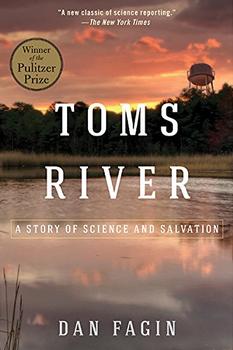Summary | Excerpt | Reviews | Beyond the Book | Readalikes | Genres & Themes | Author Bio

A Story of Science and Salvation
by Dan Fagin
The doctors ignored the chatter. Boornazian raised the issue a few times with physicians she knew well. "I would ask them, 'Have you noticed this? Do you think there's something going on in Toms River?' " The doctors all told her the same thing: no. They said it in various ways, and with inflections that ranged from respectful to patronizing, but the core message never varied. "The general sentiment from the doctors was that it was just a coincidence, and that we shouldn't worry about it," Boornazian recalled. She did not take offense. The physicians ruled the hospital, and CHOP was not just any hospital. It was the oldest and most prestigious children's hospital in the United States, regularly finishing at the top of national rankings for pediatric care. How could the doctors be expected to pay attention to something as trivial as a home address? They were far too busy to get to know the families the way the nurses did. "The doctors rotate in and out, and I don't think they really realized how many patients there were who were from the Toms River area," Boornazian said. "It's the nurses who are there day in and day out, year after year. To us, it looked like a very unusual number of patients."
When Boornazian told other nurses on the ward that she was planning to drive to Toms River for Carrie-Anne Carter's funeral, they responded with wisecracks that were only half in jest. "People said, 'Oh, don't drink the water when you're there, and don't breathe too deeply,' " Boornazian remembered. From conversations with the Carters and other Toms River families, she had heard a little bit about the Ciba-Geigy chemical plant and its history of pollution. So she was a bit unnerved when, while driving to the funeral, she looked to her left at a stoplight on Route 37 and saw the fence and security gate of the sprawling factory complex. "I remember driving by and thinking, 'That's the plant that everyone talks about.' " For days afterward, she could not stop thinking about that big factory in the woods and about all the local families she had met in the oncology ward.
Lisa Boornazian was not a boat-rocker. In 1995, she was a twenty-four-year-old who loved her job and respected the hierarchy of the hospital. The doctors had told her it was just a coincidence that so many children on the ward were from Toms River, and she was inclined to take their word for it. They were very good doctors, and they gave their patients excellent medical care, even if they were too busy to get to know them. But she could not shake her uneasy feeling that the doctors might be wrong about Toms River.
She and her husband, Adam, came from large families and often got together on weekends with their siblings, many of whom still lived in the Philadelphia area. They were especially close to Adam's sister, Laura Janson, and her husband, Eric. A few weeks after Carrie-Anne Carter's funeral in Toms River in February of 1995, the two couples were having dinner on a Friday night, and somehow the conversation turned to the funeral and to Boornazian's worries about Toms River. The discussion was not something that she had planned. "It just sort of happened by accident," she would remember much later.
In their extended family, Laura Janson was an authority figure on environmental matters. She worked in the Philadelphia regional office of the U.S. Environmental Protection Agency, where she specialized in technical assessments of hazardous waste sites, though she had never worked on any in Toms River. After eleven years at the EPA, Janson was a bit jaded about information that came in from the public because it usually turned out to be confused, poorly documented, or otherwise unreliable. But this was different. Her sister-in-law was not an alarmist; she was a medical professional at a major hospital where thousands of children were treated every year. At dinner, when Boornazian started talking about all the sick children she had treated from Toms River, Janson listened. When Boornazian asked her to check to see if anyone at the EPA was looking into the issue, she agreed. Janson would later explain her decision this way: "When you work at EPA, people are always saying something's wrong with their water, but if it's your sister-in-law talking, and she's a nurse at CHOP who has made actual observations of cancer in children, you figure you'd better follow up."
Excerpted from Toms River by Dan Fagin. Copyright © 2013 by Dan Fagin. Excerpted by permission of Bantam, a division of Random House, Inc. All rights reserved. No part of this excerpt may be reproduced or reprinted without permission in writing from the publisher.
Your guide toexceptional books
BookBrowse seeks out and recommends the best in contemporary fiction and nonfiction—books that not only engage and entertain but also deepen our understanding of ourselves and the world around us.